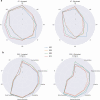Machine learning prediction and classification of behavioral selection in a canine olfactory detection program
- PMID: 37528118
- PMCID: PMC10394074
- DOI: 10.1038/s41598-023-39112-7
Machine learning prediction and classification of behavioral selection in a canine olfactory detection program
Abstract
There is growing interest in canine behavioral research specifically for working dogs. Here we take advantage of a dataset of a Transportation Safety Administration olfactory detection cohort of 628 Labrador Retrievers to perform Machine Learning (ML) prediction and classification studies of behavioral traits and environmental effects. Data were available for four time points over a 12 month foster period after which dogs were accepted into a training program or eliminated. Three supervised ML algorithms had robust performance in correctly predicting which dogs would be accepted into the training program, but poor performance in distinguishing those that were eliminated (~ 25% of the cohort). The 12 month testing time point yielded the best ability to distinguish accepted and eliminated dogs (AUC = 0.68). Classification studies using Principal Components Analysis and Recursive Feature Elimination using Cross-Validation revealed the importance of olfaction and possession-related traits for an airport terminal search and retrieve test, and possession, confidence, and initiative traits for an environmental test. Our findings suggest which tests, environments, behavioral traits, and time course are most important for olfactory detection dog selection. We discuss how this approach can guide further research that encompasses cognitive and emotional, and social and environmental effects.
© 2023. The Author(s).
Conflict of interest statement
The authors declare no competing interests.
Figures


Similar articles
-
Genome scanning of behavioral selection in a canine olfactory detection breeding cohort.Sci Rep. 2022 Sep 2;12(1):14984. doi: 10.1038/s41598-022-18698-4. Sci Rep. 2022. PMID: 36056154 Free PMC article.
-
Application of supervised machine learning algorithms for classification and prediction of type-2 diabetes disease status in Afar regional state, Northeastern Ethiopia 2021.Sci Rep. 2023 May 13;13(1):7779. doi: 10.1038/s41598-023-34906-1. Sci Rep. 2023. PMID: 37179444 Free PMC article.
-
Canine olfactory detection and its relevance to medical detection.BMC Infect Dis. 2021 Aug 19;21(1):838. doi: 10.1186/s12879-021-06523-8. BMC Infect Dis. 2021. PMID: 34412582 Free PMC article. Review.
-
Machine learning based canine posture estimation using inertial data.PLoS One. 2023 Jun 21;18(6):e0286311. doi: 10.1371/journal.pone.0286311. eCollection 2023. PLoS One. 2023. PMID: 37342986 Free PMC article.
-
Machine learning approach to gene essentiality prediction: a review.Brief Bioinform. 2021 Sep 2;22(5):bbab128. doi: 10.1093/bib/bbab128. Brief Bioinform. 2021. PMID: 33842944 Review.
Cited by
-
The Use of Triaxial Accelerometers and Machine Learning Algorithms for Behavioural Identification in Domestic Dogs (Canis familiaris): A Validation Study.Sensors (Basel). 2024 Sep 13;24(18):5955. doi: 10.3390/s24185955. Sensors (Basel). 2024. PMID: 39338701 Free PMC article.
References
-
- Cleghern, Z., et al. Behavioral and Environmental Analytics from Potential Guide Dogs with IoT Sensor Data Informed by Expert Insight. ACM International Conference Proceeding Series, August 2021. (2020).
Publication types
MeSH terms
LinkOut - more resources
Full Text Sources

